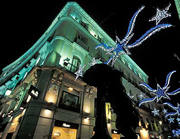
The Christmas feasting starts, as in many Catholic countries, on Christmas Eve -Nochebuena with a huge meal, usually turkey filled with plums and pine nuts.
But in Madrid, they have a slightly more exotic version, starting with shellfish soup, followed by lamb, bream and prawns. In Catalonia, there is a soupy stew a mixture of fish, meat and vegetables. It is followed by turkey. The desert is usually turron a kind of sweet nougat.
Families then attend Misa del Gallo – Midnight Mass on Christmas Eve. Christmas carols have a livelier rhythm and spicier lyrics than their more solemn versions in other parts of the world.
There's more feasting on Christmas Day – Navidad, as a rule with turkey. Afterwards, the family usually go to visit relatives. Unsurprisingly, it is a good excuse to have a drink too. Christmas pastries will be offered along with a glass of sweet anise liqueur. But Cava is the favourite tipple.
One thing that seems peculiar to those from the English-speaking world is that Christmas doesn't stop on Boxing Day but carries right on until 6 January or Los Reyes. And instead of singing about partridges and pear trees and the 12 days of Christmas, Spaniards really do mark every day.
Before Christmas, Spaniards prepare the Belén the Nativity scene with clay figurines representing shepherds and Roman soldiers, shopkeepers and housewives, as well as Mary, Joseph and the baby Jesus. They can take this to great lengths.
A few days after Christmas Day, they celebrate the Day of the Innocents on 28 December, when King Herod killed the infants in Judea. But it is treated like the British April Fool's Day, town fountains are filled with soap suds and newspapers carry spoof stories.
Strangely, though Christmas in many other countries is all about children, Spanish youngsters have to wait, at least traditionally, until 6 January and Epiphany for their presents. The Spanish version of Santa Claus is Los Reyes Magos the Three Wise Men, who bore gifts to the infant Jesus. The night before, 5 January, Spanish children will put a pair of shoes outside the bedroom door and then they will head for the streets to watch the Cabalgata parade, which heralds the arrival of the Reyes Magos. Each of the Three Wise Men will be riding on a float and throwing sweets to the delighted children. Although the procession does differ between areas in Spain. For example in Murcia, the Kings will bring more than 20,000 presents and 2,000 kilogram's of sweets. In Andalucia, where almost every town or village will have its own cabalgata, one of the most unusual will be in Higuera de la Sierra
where 200 people are to take part in a cortege with different scenes. But the people will remain absolutely still throughout. The only ones allowed to move are The Kings. In Alarilla, near Guadalajara, the Three Kings are to descend from the mountainside accompanied by a torchlight procession. In Madrid, camels are to carry the Kings through the city to the Puerta del Sol .In the Canary Islands, the Three Kings are to arrive by helicopter on the island of Tenerife!
After the parade, the children will return to their homes to find their presents waiting for them.
New Year – Grape Expectations
Aside from this Catalan speciality, another festive custom which seems to delight foreigners is gulping down 12 grapes on New Year's Eve. As the 12 bells sound out from Madrid's Puerta del Sol and are beamed around the country live on television, you have to eat a grape, one for each chime. Spaniards are known to cheat at this, buying specially-peeled grapes in supermarkets, so the whole business is easier.
It is thought that eating the grapes brings you good luck. But the truth is that it was an invention dreamed up by wine-growers to boost their coffers. Like many Christmas traditions the world over, it has more to do with commercial ingenuity than sacred ritual.
It is said that early in the last century a bumper harvest of grapes left growers with more than they could handle. So they dreamed up this 'custom' and somehow the idea caught on.
However, even if the grape-eating has no roots in history, then other culinary customs do. Early Iberians are believed to have marked the winter solstice (the time of year when days start getting longer and the nights shorter) with some sort of fire ritual. The Romans, who ruled Spain for five centuries, devoted this time of year to their Saturnalia festival, a period of eating, drinking and gift-giving. Many of the Christmas pastries to which Spaniards are addicted were originally Sephardic Jewish and Moorish recipes, adding to the multi-cultural heritage of the winter holidays in Spain.



















